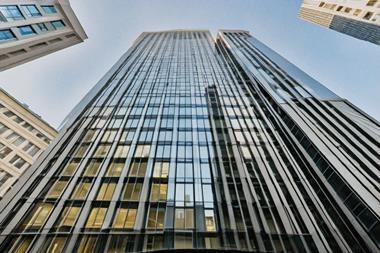Kevin White and Leonard Mills examine the causes and consequences of the credit crunch kicked off in the US residential property market
The roots of the credit crunch lie in the US, where a wave of residential refinancings in 2003 and 2004 led to a build-up of excess capacity - in people and technology - in the mortgage industry. As the pace of refinancings ebbed, the industry resorted to creating new products (eg, interest-only, short-dated hybrid adjustable rate, payment-option, and low-documentation mortgages) and extended credit to riskier sub-prime borrowers to keep the magic alive. The rating agencies and securitisation arms of the investment banks - also anxious to employ their capacity - facilitated the process, packaging and rating securities backed by the new mortgages, which were snapped up by hedge funds and international investors.
What happened? Interest rates began rising, the economy began to slow, origination volumes abated, and the residential real estate price boom subsided. In the absence of rising home prices, loan-to-value ratios ceased falling, and in some places began rising. Unable to roll their resetting mortgages into new loans, sub-prime borrowers defaulted.
Investors started to worry. The models used to evaluate these new mortgage-backed securities were largely based on historical experience but there was no precedent for a situation where sub-prime and other new mortgages were so prevalent. The values of the loans originators were warehousing for securitisation collapsed. Nursing big losses and blocked from issuing new securities, providers of short-term liquidity began to restrict credit to originators, which curtailed mortgage lending. Reduced demand because of more limited mortgage financing and increased supply from foreclosures set off a downward cycle.
The financial impact spread to other credit markets, including commercial real estate. The spillover occurred because of concerns that the housing sector would drag the entire economy into recession, thereby reducing property incomes; and reports of similarly lax lending practices in the commercial mortgage industry, including interest-only terms, higher loan-to-value ratios, and underwriting to projected rather than actual income.
The US economy has stumbled but the consensus opinion is that a recession will be avoided. Nevertheless, pricing and credit availability for commercial real estate has been affected. For example, whole-loan CMBS spreads averaged 98 basis points (bps) in the first half of 2007 and rose to an average of 142bps in the third quarter. After averaging $23.6bn (€16.5bn) per month during the first eight months of 2007, CMBS issuance dropped to $8.2bn in September and will likely total $5.7bn in October. Before the crunch, spreads in the private lending market were above those in the CMBS market.
Credit volumes are substantially down, and credit pricing has increased by about
50bps in commercial mortgage markets. Based on our survey of real estate investors, this has led to a 30bps increase in cap rates - but only very recently - implying a drop in property values of about 4.5%, other things being equal.
In Europe, the financial impact has been less pronounced. Yields on investment-grade corporate bonds have not changed dramatically: while credit spreads have widened, base rates have dropped as investors have fled for safety. A dearth of liquidity and increased risk aversion in interbank lending markets pushed five-year swap rates up by about 80bps through June, but they have since receded as financial markets have stabilised; swap rates are now up only 20-40bps from the beginning of the year.
Still, Europe will not escape unscathed. Agents report healthy third-quarter investment volumes but these figures largely reflect deals that were arranged and financed earlier in the year. CMBS issuance halted; after averaging $7.2bn per month through August, there were no new issues in September and October. Loan securitisations on two of the year's largest acquisitions - HSBC's Canary Wharf HQ and the Coeur Défense building in Paris - have been put on hold. Lending criteria have stiffened: loan-to-value ceilings have dropped from 90% to 70%. IPD monthly data indicated that UK property values fell 2.2% from June to September.
If the US economy does not sink into recession, the impact on commercial real estate will be contained but clearly noticeable. In addition to the pricing effects, we expect an increase in problem loans for commercial mortgages. However, if the US economy does go into recession - a risk that has clearly heightened - these projected losses will increase by 50%. A recession would be a double whammy for commercial real estate, combining the current credit problems on the financing side with slumping demand on the fundamentals side. This scenario is reminiscent of the commercial real estate world during the 2001-02 recession, although not as nasty as that in 1991-92, when supply was running amok.
Risks to the economy are less acute in Europe. Some housing markets look vulnerable to a correction - the UK, Spain, and Ireland top the list — but the absence of a large-scale sub-prime mortgage problem minimises the likelihood of a severe housing crash. Property markets, too, are in good shape. Record profits and rising household incomes will continue to support office-using employment growth and retail sales. More supply will surface, as projects initiated over the past couple of years, when capital was plentiful, come to fruition. However, rising commodity and financing costs will curb new construction starts, capping deliveries later in the decade. The good news is that vacancies in most markets are low enough to generate rent growth in line with or slightly above inflation.
Given solid economic and real estate fundamentals, loan performance should remain quite healthy. Real estate pricing is more fragile: the drought in public debt markets and liquidity constraints among investment banks will choke credit financing for major deals. However, Europe's CMBS market is relatively immature: RREEF estimates that it accounts for just 6% of total real estate financing, compared with 21% in the US. Balance sheet lenders and equity investors, newly competitive against their CMBS-conduit and highly leveraged counterparts, are positioned to win more deals and backstop pricing.
Overall, yields across most of continental Europe should remain stable in the near term, increasing by 30bps over five years as interest rates gradually escalate and rent growth subsides. The story is quite different in the UK and, in particular, London, where the economy and property fundamentals are more exposed to financial-sector employment and housing risks; leverage levels are higher; CMBS financing is more prevalent; and pricing levels are more stretched (relative to financing costs). London will see a more immediate 40bps correction before pricing stabilises, and an even greater increase if the economy is hit with a US-style housing slump.
In general, the fallout from the credit crunch should prove similar to that of 1998, when global credit markets were convulsed by the Asian and Russian financial crises - that is, contained and transitory.
Kevin White (left), senior economist, at Property & Portfolio Research and Leonard Mills, director of debt research and risk management












